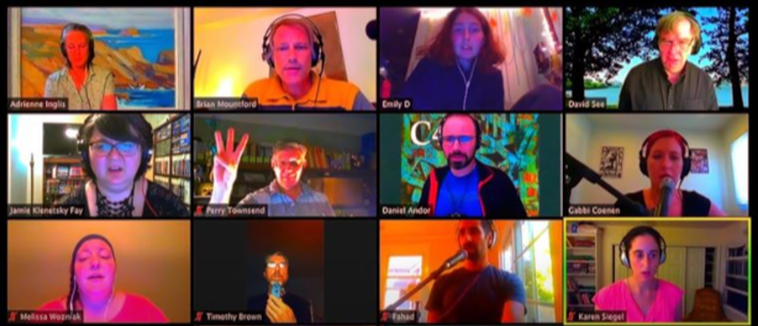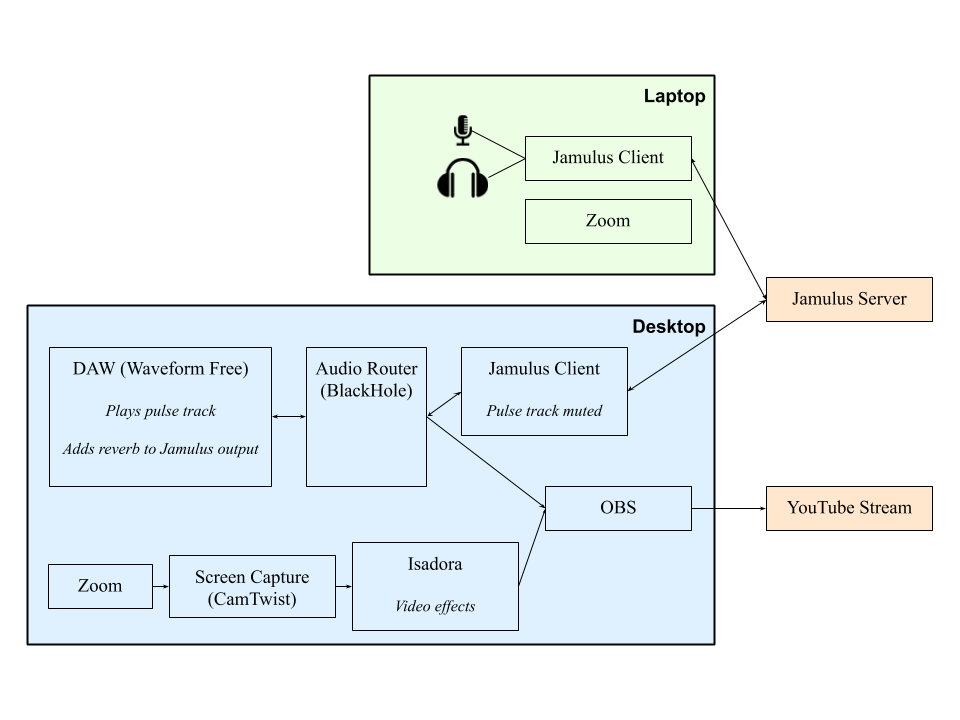Remote Livestream #2:
How Low Can We Go? - C4 Goes Low Latency
PROGRAM
Want to read more about the technology involved in these performances?
Scroll to the bottom of the page!
Scroll to the bottom of the page!
"The Next Child Waits"
by Brian Mountford
on the poem by Carl Sandberg
(world premiere)
I wrote "The Next Child Waits" specifically for the remote collaboration exploration sessions that led to these livestream mini-concerts. In order to accommodate the unavoidable latency in performance, and inspired by Ray Lustig’s instrumental piece Latency Canons, I tried to create a texture with a bit of offset between the parts already written in, so that the extra delays between parts would be icing on the cake. I found the poem appropriate for this difficult time. It has a contemplative tone, but with an underlying confidence in our universal interconnectedness.
~ Brian Mountford
TEXT
I know the city waits… the next child waits… there
is a great singing Mother.
Our earth of a turning ball – who set it swinging? A great
Nobody? Who put the People down on the wire-grass
wilderness? A great Nobody?
I have listened to the tides of the sea trying to spell the
word. I have walked under tall trees and heard winter
winds trying to write the high sign of it. I have felt
the magnet pull of it under the shoes of my feet in the
dirt of a prairie road.
I know the city waits… the next child waits… there
is a great singing Mother.
O God, thy sea is so great…
by Sarah Rimkus
for SATB choir
“O God, thy sea is so great and my boat is so small” is the opening to an old Breton fisherman’s prayer. It was inscribed on a small plaque given to President John F. Kennedy by Admiral Hyman Rickover, who gave the quote to all new submarine captains entering Naval service under his command. It became a favourite quote of the President’s, and he kept this plaque on his Oval Office desk throughout his time in office. It now resides on display at the Kennedy Presidential Library. This piece sets this text in a way that hopefully communicates the vast beauty and terror of the world that humanity has to contend with, along with the importance of mindfulness and humility in our relationship with the world for all people, particularly our leaders.
~ Sarah Rimkus
TEXT
O God, thy sea is so great and my boat is so small…
Love Is Anterior to Life
by Bettina Sheppard
on the poem by Emily Dickinson
“Love Is Anterior to Life” is part of a larger song cycle of Emily Dickinson poetry settings originally performed at Hunter College’s Lang Recital Hall. Excerpts have since been included in concerts at Lincoln Center’s Alice Tully Hall and at New York City Center.
The four-line poem appears in Dickinson’s idiosyncratic style of broken textual lines interrupted by dashes. Each line is brilliantly separate and concise while allowing a sense of flow and eternity. Sopranos, altos, and tenors are each assigned one line with its own melody and metrical form, which is then repeated throughout. Only basses sing the entire poem, while the second alto simply sings the word “love.” We feel the choppy nature of the poem with its distinct thoughts, but also the repetitive, eternal cycle of life and death.
~ Bettina Sheppard
text
Love – is anterior to Life –
Posterior – to Death –
Initial of Creation, and
The Exponent of Breath
by Brian Mountford
on the poem by Carl Sandberg
(world premiere)
I wrote "The Next Child Waits" specifically for the remote collaboration exploration sessions that led to these livestream mini-concerts. In order to accommodate the unavoidable latency in performance, and inspired by Ray Lustig’s instrumental piece Latency Canons, I tried to create a texture with a bit of offset between the parts already written in, so that the extra delays between parts would be icing on the cake. I found the poem appropriate for this difficult time. It has a contemplative tone, but with an underlying confidence in our universal interconnectedness.
~ Brian Mountford
TEXT
I know the city waits… the next child waits… there
is a great singing Mother.
Our earth of a turning ball – who set it swinging? A great
Nobody? Who put the People down on the wire-grass
wilderness? A great Nobody?
I have listened to the tides of the sea trying to spell the
word. I have walked under tall trees and heard winter
winds trying to write the high sign of it. I have felt
the magnet pull of it under the shoes of my feet in the
dirt of a prairie road.
I know the city waits… the next child waits… there
is a great singing Mother.
O God, thy sea is so great…
by Sarah Rimkus
for SATB choir
“O God, thy sea is so great and my boat is so small” is the opening to an old Breton fisherman’s prayer. It was inscribed on a small plaque given to President John F. Kennedy by Admiral Hyman Rickover, who gave the quote to all new submarine captains entering Naval service under his command. It became a favourite quote of the President’s, and he kept this plaque on his Oval Office desk throughout his time in office. It now resides on display at the Kennedy Presidential Library. This piece sets this text in a way that hopefully communicates the vast beauty and terror of the world that humanity has to contend with, along with the importance of mindfulness and humility in our relationship with the world for all people, particularly our leaders.
~ Sarah Rimkus
TEXT
O God, thy sea is so great and my boat is so small…
Love Is Anterior to Life
by Bettina Sheppard
on the poem by Emily Dickinson
“Love Is Anterior to Life” is part of a larger song cycle of Emily Dickinson poetry settings originally performed at Hunter College’s Lang Recital Hall. Excerpts have since been included in concerts at Lincoln Center’s Alice Tully Hall and at New York City Center.
The four-line poem appears in Dickinson’s idiosyncratic style of broken textual lines interrupted by dashes. Each line is brilliantly separate and concise while allowing a sense of flow and eternity. Sopranos, altos, and tenors are each assigned one line with its own melody and metrical form, which is then repeated throughout. Only basses sing the entire poem, while the second alto simply sings the word “love.” We feel the choppy nature of the poem with its distinct thoughts, but also the repetitive, eternal cycle of life and death.
~ Bettina Sheppard
text
Love – is anterior to Life –
Posterior – to Death –
Initial of Creation, and
The Exponent of Breath
C4: the Choral Composer/Conductor Collective Members & Guests Performing:
Daniel Andor-Ardó
Timothy Brown
Gabbi Coenen
Emily Drossell
Jamie Klenetsky Fay
Mario Gullo
Adrienne Inglis (Inversion Ensemble)
Maya Lewis
Brian Mountford
David See
Fahad Siadat (C3LA)
Karen Siegel
Perry Townsend
Melissa Wozniak
Daniel Andor-Ardó
Timothy Brown
Gabbi Coenen
Emily Drossell
Jamie Klenetsky Fay
Mario Gullo
Adrienne Inglis (Inversion Ensemble)
Maya Lewis
Brian Mountford
David See
Fahad Siadat (C3LA)
Karen Siegel
Perry Townsend
Melissa Wozniak
Feel like making a donation to C4 to support this work with our virtual tip jar? Venmo us at @c4ensemble! (Tips can also be made via credit card through our website, as well as through PayPal at [email protected].)
Thank you for supporting the creation and performance of new choral music during this challenging time!
Thank you for supporting the creation and performance of new choral music during this challenging time!
TECH DETAILS
How are we doing all this? The short answer is that we are all connected to Jamulus, a piece of software which lets up to 50 participants share audio. For video, we are also connected to a Zoom call with the sound turned off. We combine the audio from Jamulus and the video from Zoom, and stream the results to YouTube.
Of course it’s a bit more complicated than that. Here is an in-depth description of the setup that I (Brian Mountford, the person in charge of streaming) am using at home to try and both sing in the group and simultaneously stream the results. See the diagram below for an overview.
First off, there are two computers. I am using my laptop to be a singer. Like all the other singers, I am running both Jamulus and Zoom. Jamulus is connected to our private Jamulus server, and Zoom is connected to a call set up by Karen Siegel, another of our members. I have my headphones on, and a microphone to sing into, and am using Zoom to watch the conductor as needed. For more information about using Jamulus for choral singing, see our in-depth document.
Then there is my desktop computer (a Mac Mini), which handles the streaming. Much of the software described below is Mac-specific, but there should be Windows equivalents for everything. The desktop is connected to both Jamulus and Zoom. Yes, I am connected twice, once from each computer. But the desktop is connected to Zoom with no camera, so we have hidden that in the Zoom output. All it is doing is watching everyone else. Likewise, the Jamulus connection has no microphone or headphones. In addition, the Jamulus client is set to mute itself in the mixer panel, for reasons to be made apparent later.
The audio and video are processed very differently, so let me cover them separately. First, the audio. I am running a DAW (digital audio workstation). I am using Waveform Free, but you could use any number of programs for this; see our Jamulus document for details. The DAW has two purposes. First, it is the source of the pulse track we follow to perform one of the pieces. I made a audio recording of it, and the DAW just plays it into the Jamulus client, from whence it gets distributed to everyone’s headphones. Second, the DAW takes the returned sound from Jamulus and adds reverb to make it sound better, before sending it out to OBS to be streamed. Note that, if we aren’t careful, the pulse track will also come back from Jamulus, and assault the ears of our listeners. This is why we need to set the desktop’s Jamulus connection to mute itself. That way, although the singers hear the track, the audience does not. Magic!
In order to route the audio around between different programs, audio routing software is needed. I am using BlackHole, a free piece of software that lets programs send and receive a total of 16 channels of data. I use channels 1 and 2 to send from the DAW to OBS, channels 3 and 4 to send from the DAW to Jamulus, and channels 5 and 6 to send from Jamulus back to the DAW.
Now the video side of things. The nature of the Zoom software makes it difficult to capture the video output. One way I found to do it is a program called CamTwist, which is set up to capture a certain portion of the screen (I connected a second monitor so I would have plenty of screen real estate). I then move the Zoom video window to exactly the part of the screen CamTwist is looking at, and CamTwist grabs the feed. CamTwist is then set to act as a Syphon server. Syphon is a method for routing video on the Mac, not unlike BlackHole routes the audio.
To do some video processing, I use Isadora. Isadora takes in the Syphon feed, adds whatever crazy effects we feel like using, and sends the result out as another Syphon feed. I experimented with also using Isadora to delay the video slightly so it would be in better sync with the audio, but it put too much strain on my little Mac Mini, so I had to abandon the effort.
Finally, OBS, a popular streaming application, puts everything together. It is configured to get the audio stream from the DAW via the BlackHole router, and the video from Isadora's Syphon output, combine the two and send the results to YouTube’s streaming service. With a little luck, the results show up in the audience's browsers 20 seconds later.
Of course it’s a bit more complicated than that. Here is an in-depth description of the setup that I (Brian Mountford, the person in charge of streaming) am using at home to try and both sing in the group and simultaneously stream the results. See the diagram below for an overview.
First off, there are two computers. I am using my laptop to be a singer. Like all the other singers, I am running both Jamulus and Zoom. Jamulus is connected to our private Jamulus server, and Zoom is connected to a call set up by Karen Siegel, another of our members. I have my headphones on, and a microphone to sing into, and am using Zoom to watch the conductor as needed. For more information about using Jamulus for choral singing, see our in-depth document.
Then there is my desktop computer (a Mac Mini), which handles the streaming. Much of the software described below is Mac-specific, but there should be Windows equivalents for everything. The desktop is connected to both Jamulus and Zoom. Yes, I am connected twice, once from each computer. But the desktop is connected to Zoom with no camera, so we have hidden that in the Zoom output. All it is doing is watching everyone else. Likewise, the Jamulus connection has no microphone or headphones. In addition, the Jamulus client is set to mute itself in the mixer panel, for reasons to be made apparent later.
The audio and video are processed very differently, so let me cover them separately. First, the audio. I am running a DAW (digital audio workstation). I am using Waveform Free, but you could use any number of programs for this; see our Jamulus document for details. The DAW has two purposes. First, it is the source of the pulse track we follow to perform one of the pieces. I made a audio recording of it, and the DAW just plays it into the Jamulus client, from whence it gets distributed to everyone’s headphones. Second, the DAW takes the returned sound from Jamulus and adds reverb to make it sound better, before sending it out to OBS to be streamed. Note that, if we aren’t careful, the pulse track will also come back from Jamulus, and assault the ears of our listeners. This is why we need to set the desktop’s Jamulus connection to mute itself. That way, although the singers hear the track, the audience does not. Magic!
In order to route the audio around between different programs, audio routing software is needed. I am using BlackHole, a free piece of software that lets programs send and receive a total of 16 channels of data. I use channels 1 and 2 to send from the DAW to OBS, channels 3 and 4 to send from the DAW to Jamulus, and channels 5 and 6 to send from Jamulus back to the DAW.
Now the video side of things. The nature of the Zoom software makes it difficult to capture the video output. One way I found to do it is a program called CamTwist, which is set up to capture a certain portion of the screen (I connected a second monitor so I would have plenty of screen real estate). I then move the Zoom video window to exactly the part of the screen CamTwist is looking at, and CamTwist grabs the feed. CamTwist is then set to act as a Syphon server. Syphon is a method for routing video on the Mac, not unlike BlackHole routes the audio.
To do some video processing, I use Isadora. Isadora takes in the Syphon feed, adds whatever crazy effects we feel like using, and sends the result out as another Syphon feed. I experimented with also using Isadora to delay the video slightly so it would be in better sync with the audio, but it put too much strain on my little Mac Mini, so I had to abandon the effort.
Finally, OBS, a popular streaming application, puts everything together. It is configured to get the audio stream from the DAW via the BlackHole router, and the video from Isadora's Syphon output, combine the two and send the results to YouTube’s streaming service. With a little luck, the results show up in the audience's browsers 20 seconds later.
|
|
|
C4 is funded in part by:
C4 is a proud member of:
New York Choral Consortium |
Receive our newsletter:
Support C4's Mission!
|







